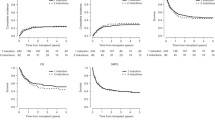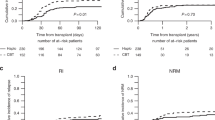Abstract
Attempts to optimize outcomes in cord blood transplantation (CBT) by using new conditioning regimens and standardization of cord blood unit selection are warranted. In all, 88 patients (18 children and 70 adults) with hematological malignancy from nine Spanish institutions underwent a single-unit CBT after an i.v. BU-based myeloablative conditioning regimen. All evaluable patients except one engrafted. The overall cumulative incidence (CI) of myeloid engraftment was 94% at a median time of 19 days. In multivariate analysis, nonadvanced disease stage was the only factor with a favorable impact on myeloid engraftment. The CI of acute GVHD grades II–IV and chronic extensive GVHD were 24% each. The CI of nonrelapse mortality at 100 days, 180 days and 5 years was 14, 23 and 44%, respectively. The 5-year CI of relapse was 18%, whereas disease-free survival (DFS) was 46%, 39% and 11% for patients transplanted in early, intermediate and advanced stages of the disease, respectively. Our study shows high rates of engraftment with fast neutrophil recovery in patients undergoing single-unit CBT using a BU-based conditioning regimen. Long-term DFS can be achieved in a substantial number of patients with high-risk hematological malignancies, particularly when transplanted in an early stage of the disease.
This is a preview of subscription content, access via your institution
Access options
Subscribe to this journal
Receive 12 print issues and online access
$259.00 per year
only $21.58 per issue
Buy this article
- Purchase on Springer Link
- Instant access to full article PDF
Prices may be subject to local taxes which are calculated during checkout



Similar content being viewed by others
References
Sanz MA . Cord-blood transplantation in patients with leukemia — a real alternative for adults. N Engl J Med 2004; 351: 2328–2330.
Smith AR, Wagner JE . Alternative haematopoietic stem cell sources for transplantation: place of umbilical cord blood. Br J Haematol 2009; 147: 246–261.
Barker JN, Weisdorf DJ, DeFor TE, Blazar BR, McGlave PB, Miller JS et al. Transplantation of two partially HLA-matched umbilical cord blood units to enhance engraftment in adults with hematologic malignancy. Blood 2005; 105: 1343–1347.
Fernandez MN, Regidor C, Cabrera R, García-Marco JA, Forés R, Sanjuán I et al. Unrelated umbilical cord blood transplant in adults: early recovery of neutrophils by supportive co-transplantation of a low number of highly purified peripheral blood CD34+ cells from an HLA haploidentical donor. Exp Hematol 2003; 31: 535–544.
Shpall EJ, Quinones R, Giller R, Zeng C, Baron AE, Jones RB et al. Transplantation of ex vivo expanded cord blood. Biol Blood Marrow Transplant 2002; 8: 368–376.
Frassoni N, Gualandi F, Modesta M, Raiola AM, Ibatici A, Piaggio G et al. Direct intrabone transplant of unrelated cord-blood cells in acute leukaemia: a phase I/II study. Lancet Oncol 2008; 9: 831–839.
Sanz GF, Saavedra S, Planelles D, Senent L, Cervera J, Barragán E et al. Standardized unrelated donor cord blood transplantation in adults with hematologic malignancies. Blood 2001; 98: 2332–2338.
De Lima M, Couriel D, Thall PF . Once-daily busulfan and fludarabine: clinical and pharmacokinetics results of a myeloablative reduced toxicity conditioning regimen for allogeneic stem cell transplantation in AML and MDS. Blood 2004; 104: 857–864.
Montesinos P, Sanz J, Cantero S, Lorenzo I, Martin G, Saavedra S et al. Incidence outcome and risk factors of cytomegalovirus infection and disease after umbilical cord-blood transplantation in adult patients. Biol Blood Marrow Transplant 2009; 15: 730–740.
Glucksberg H, Storb R, Fefer A, Buckner CD, Neiman PE, Clift RA et al. Clinical manifestations of graft-versus-host disease in human recipients of HLA-matched sibling donors. Transplantation 1974; 18: 295–304.
Przepiorka D, Weisdorf D, Martin P, Klingemann HG, Beatty P, Hows J et al. Consensus conference on acute GVHD grading. Bone Marrow Transplant 1995; 15: 825–828.
Shulman HM, Sullivan KM, Weiden PI, McDonald GB, Striker GE, Sale GE et al. Chronic graft-versus-host syndrome in man: a long-term clinicopathologic study of 20 Seattle patients. Am J Med 1980; 69: 204–217.
Gooley TA, Leisenring W, Crowley JA, Storer BE . Estimation of failure probabilities in the presence of competing risks: new representations of old estimators. Stat Med 1999; 18: 665–706.
Fine JP, Gray RJ . A proportional hazards model for subdistribution of a competing risk. J Am Stat Assoc 1999; 94: 496–509.
Kaplan EL, Meier P . Nonparametric estimation from incomplete observations. J Am Stat Assoc 1958; 53: 457–481.
Mantel N . Evaluation of survival data and two new rank order statistics arising in its consideration. Cancer Chemother Rep 1966; 50: 163–170.
Cox DR . Regression models and life tables (with discussion). J R Stat Soc B 1972; 34: 187–220.
Dixon WJ . BMDP Statistical Software. University of California Press: Berkeley, CA, 1990.
Eapen M, Rubinstein P, Zhang MJ, Stevens C, Kurtzberg J, Scaradavou A et al. Outcomes of transplantation of unrelated donor umbilical cord blood and bone marrow in children with acute leukemia: a comparison study. Lancet 2007; 369: 1947–1954.
Rocha V, Labopin M, Sanz G, Arcese W, Schwerdtfeger R, Bosi A et al. Transplants of umbilical-cord blood or bone marrow from unrelated donors in adults with acute leukemia. N Engl J Med 2004; 351: 2276–2285.
Laughlin MJ, Eapen M, Rubinstein P, Wagner JE, Zhang MJ, Champlin RE et al. Outcomes after transplantation of cord blood or bone marrow from unrelated donors in adults with leukemia. N Engl J Med 2004; 351: 2265–2275.
Horwitz ME, Morris A, Gasparetto C, Sullivan K, Long G, Chute J et al. Myeloablative intravenous busulfan/fludarabine conditioning does not facilitate reliable engraftment of dual umbilical cord blood grafts in adult recipients. Biol Blood Marrow Transplant 2008; 14: 591–594.
Papadopoulos EB, Carabasi MH, Castro-Malaspina H, Childs BH, Mackinnon S, Boulad F et al. T-cell-depleted allogeneic bone marrow transplantation as postremission therapy for acute myelogenous leukemia: freedom from relapse in the absence of graft-versus-host disease. Blood 1998; 91: 1083–1090.
Aversa F, Tabilio A, Velardi A, Cunningham I, Terenzi A, Falzetti F et al. Treatment of high-risk acute leukemia with T-cell-depleted stem cells from related donors with one fully mismatched haplotype. N Engl J Med 1998; 339: 1186–1193.
Moscardó F, Sanz J, Senent L, Cantero S, de la Rubia J, Montesinos P et al. Impact of hematopoietic chimerism at day +14 on engraftment after unrelated donor umbilical cord blood transplantation for hematologic malignancies. Haematologica 2009; 94: 827–832.
Ooi J, Takahashi S, Tomonari A, Tsukada N, Konuma T, Kato S et al. Unrelated cord blood transplantation after myeloablative conditioning in adults with acute myelogenous leukemia. Biol Blood Marrow Transplant 2008; 14: 1341–1347.
Brunstein CG, Barker JN, Weisdorf DJ, DeFor TE, Miller JS, Blazar BR et al. Umbilical cord blood transplantation after nonmyeloablative conditioning: impact on transplant outcomes in 110 adults with hematological disease. Blood 2007; 110: 3064–3070.
MacMillan ML, Weisdorf DJ, Brunstein CG, Cao Q, DeFor TE, Verneris MR et al. Acute graft-versus-host disease after unrelated donor cord blood transplantation: analysis of risk factors. Blood 2009; 113: 2410–2415.
Acknowledgements
We thank David Pellicer for data collection and management. This study was supported by a Pierre Fabre Ibérica unrestricted research grant.
Author Contributions: JS and GFS conceived the study and interpreted the data; JS, MAS and GFS wrote the paper; JS performed the statistical analyses; JCHB, CM, MG, CF, DS, CDH, CB, AMM and CS reviewed the manuscript and contributed to the final draft.
Author information
Authors and Affiliations
Consortia
Corresponding author
Ethics declarations
Competing interests
The authors declare no conflict of interest.
Rights and permissions
About this article
Cite this article
Sanz, J., Boluda, J., Martín, C. et al. Single-unit umbilical cord blood transplantation from unrelated donors in patients with hematological malignancy using busulfan, thiotepa, fludarabine and ATG as myeloablative conditioning regimen. Bone Marrow Transplant 47, 1287–1293 (2012). https://doi.org/10.1038/bmt.2012.13
Received:
Revised:
Accepted:
Published:
Issue Date:
DOI: https://doi.org/10.1038/bmt.2012.13
Keywords
This article is cited by
-
Comparison of fludarabine/melphalan (FluMel) with fludarabine/melphalan/BCNU or thiotepa (FBM/FTM) in patients with AML in first complete remission undergoing allogeneic hematopoietic stem cell transplantation – a registry study on behalf of the EBMT Acute Leukemia Working Party
Bone Marrow Transplantation (2024)
-
Myeloablative conditioning regimens in adult patients with acute myeloid leukemia undergoing allogeneic hematopoietic stem cell transplantation in complete remission: a systematic review and network meta-analysis
Bone Marrow Transplantation (2023)
-
Myeloablative conditioning with thiotepa-busulfan-fludarabine does not improve the outcome of patients transplanted with active leukemia: final results of the GITMO prospective trial GANDALF-01
Bone Marrow Transplantation (2022)
-
Adding melphalan to fludarabine and a myeloablative dose of busulfan improved survival after allogeneic hematopoietic stem cell transplantation in a propensity score-matched cohort of hematological malignancies
Bone Marrow Transplantation (2021)
-
Thiotepa–busulfan–fludarabine (TBF) conditioning regimen in patients undergoing allogeneic hematopoietic cell transplantation for myelofibrosis: an outcome analysis from the Chronic Malignancies Working Party of the EBMT
Bone Marrow Transplantation (2021)



